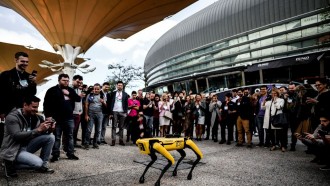
The use of artificial intelligence (AI) is becoming increasingly popular and in demand in the modern world. Companies are seeking to implement AI technologies to increase the efficiency of their business, optimise processes, as well as improve the quality of their products. However, the implementation and maintenance of AI solutions requires special tools and platforms capable of ensuring reliability, scalability and manageability of projects.
Yaroslav Starukhin, Senior Data Scientist, an expert in AI product development and its implementation, shares his experience in building an MLOps platform for the oil industry.
Yaroslav, how did you get into IT? Always had a technical bent?
I have been interested in mathematics and computer science since my early school years. These subjects came easily to me, and I was able to cope with complex mathematical problems and programming. My passion for these subjects led to a clear definition of my future career path and my choice to study applied maths and computer science for thorough training.
My first education was at the Plekhanov Russian University of Economics, where I studied Mathematical Methods in Economics. This provided me with the foundation for my future career in analytics and information technologies, including knowledge in various areas of mathematics, software engineering, and data analysis.
This was followed by studies at the Yandex School of Data Analytics, a prestigious institution in the field of data science and artificial intelligence. It was here that I deepened my knowledge of machine learning by taking advanced courses in programming, software architecture, Bayesian statistics, language technologies and other modern tools that are becoming more and more in demand in the industry.
I started working in the industry when I interned while still studying in 2016. I have gained valuable IT experience since then. Now, I enjoy applying my knowledge and skills to large-scale projects, and all my professional activities are closely related to my education and hobbies.
Tell us more about what you've done: Where did you work, and what were the challenges you have faced?
First things first: I used to work for one of the largest retailers in Eastern Europe, which was a national grocery retailer offering high service and investing heavily. The customers are a premium segment with high brand loyalty. The chain has stores in every city in the country, and its hallmark is personal service, including individual promotions and special offers in line with the loyalty programme. Loyalty cards allow a purchase history to be accumulated for each customer, which further enables the store to create these personalised promotions and improve communication with each customer.
The aim of this project is to improve the customer experience and the store's financial metrics by moving from mass promotions to targeted promotions, which typically results in increased conversions and revenue growth for the business. This kind of personalisation helps to stay competitive and stand out from other industry players. Companies that neglect such projects risk losing market share.
Upon joining the team, I was given the challenging task of organising the analytical work in this project. I designed the complete process that the team goes through from idea to large-scale campaign launch. The process involved interaction between different cross-functional team specialists and a lot of data analytics: in order to launch such a personalised promotional campaign, you need to go through hypothesis generation, simulate the campaign on historical data, run an A/B experiment for a small group of end users, evaluate the effectiveness and scalability of the campaign, decide on a full-scale launch, and automate such launches for the whole network taking into account various constraints such as frequency of communication. I was involved in implementing and testing the first versions of such promotions to fine-tune the analytical processes described: I myself developed machine learning models for predicting responses to promotions, segmenting customer groups, detecting churn and infrequent users, built A/B tests to evaluate campaign results, and created the automated pipelines to automate these processes.
Once the test turned out to be successful, the challenge was to scale the project internally by bringing in new talent, interviewing and training them on the workflow. My role was to train and educate the team and expand the product to all shop branches for continued success in the market.
I have also worked on a project that was very similar to this, but on a much larger scale, for a major Russian retailer. The main difference was that the CIS network had about seven million loyal users with registered cards, while Russia had twenty-five million. This means that the two need to be scaled up considerably. Another problem was the geographical difference: Russia has a much larger territory, with different cities, and this meant that they needed to operate, store, logistically and assortment in different ways. My role was to help the company set up the whole working process effectively and to improve face-to-face communication between the stores and customers. Finally, we developed processes to assess their financial performance. As part of the job, many in-store promotions are launched, and different hypotheses have to be tested to understand which ones are correct, where the business has been able to achieve results, and where the business has been operating at zero. To answer these questions, I developed a platform for A/B testing and processes to evaluate the financial effectiveness of the promos.
On the client side, our team identified various case studies: basket expansion, visit frequency increase, churn reduction, and others. The tool that I developed allowed me to test hypotheses (pilot launches of advertising campaigns for a small target group) and to carry out A/B experiments, given the random nature of the results. Therefore, we need to understand whether the same positive impact occurs when replicating the campaign for a larger public.
Yaroslav, you have a wealth of experience in the modern retail sector. What other sectors have you been part of?
There is a large holding company in Kazakhstan that processes copper and other ores. Its plants are of federal importance and operate on huge budgets, which is important not only for the company but also for the country itself. Each plant has its own management experience and operates in different shifts. However, when I arrived, there was no understanding of how data could be used to combine this experience from the different shifts in order to optimise the processing of the ore.
The Digital Advisor, a website based at the head office, was developed to address this. Plant operators can use the Digital Advisor to get recommendations on how to optimise the management of the units—for example, how to change the grinding and reagent levels to increase the recovery of valuable metal. These recommendations are generated by the AI system and are subject to further acceptance or rejection, resulting in changes to the operation of the plant.
This project involved a significant change as the plant's employees were used to a certain way of working and were wary of AI applications. To change the approach to working in and managing the factory, the aim was to start making data-driven decisions and extract useful insights through similar digital advisors.
Updating KPIs, conducting training, and educating employees on new management techniques were also part of the project. Ultimately, the company successfully implemented the transformation in one of the factories and then decided to extend the project to another.
Another industry where I have been fortunate enough to gain experience in applying data analytics is the automotive industry. A well-known automotive company with Japanese roots manufactures its cars in various countries around the world, has many factories and sales offices, and makes its products available in each country. However, due to the company's long history, its internal processes are not always in line with best practices, which is a hindrance to decision-making. As a result, the company is not always timely in planning the production and distribution of its vehicles.
The project I worked on involved the development of a planning system that produced optimal assembly and distribution plans for machines by country. This planning system made it possible to optimise production processes and distribution plans, taking into account the specifics of each country and market requirements. The car production and distribution process has many aspects, such as storage constraints for the cars produced, different demands in the final regions, capacity constraints on the assembly lines, different levels of profitability in different markets, and other business aspects that need to be taken into account.
Developing this system was a complex task, involving creating various components and modules, as well as integrating the work of employees at all levels. For a company that had long operated according to established patterns, the changes in business processes associated with the implementation of the new system were a major challenge.
Based on the business requirements of the planning and sales departments, my role was to develop a mathematical algorithm for planning. My role also consisted of developing a mathematical algorithm for planning based on the business requirements from the planning and sales departments, and also to provide transparency in the operation of the system, explaining how the system worked and its limits in order to help employees understand the decisions made and gain confidence in the system. Successfully integrating and using the new system took time and effort, but the project was successful, and the company became more efficient and adaptable to changing market conditions through shorter planning cycles.
What are you currently working on?
I am in the process of building an MLOps platform for the largest oil company outside of the Arab world. The project is aimed at aligning horizontal and vertical products in the company and is part of a major digital transformation. Horizontal products are functional expertise and everything that goes with it, while vertical products are products for specific use cases.
For example, a vertical product might be a digital advisor that provides recommendations for well drilling every five minutes, while a horizontal product is an MLOps platform that enables the scaling and automation of these types of products.
There is a need for constant monitoring, preferably without human input, of the machine learning patterns that underpin these AI products. This requires timely and accurate reporting on data quality and model functioning, as well as verification of results achieved by such products, and so on. Another feature of this project is that I am creating a system not just for one AI product, but to set standards for all of the company's future products.
Why is this project important?
For the client and their business, the importance of this project is critical. At the moment, there is no such combination of team, tools, and processes that can enable a company to develop dozens of AI products with hundreds of machine learning models in a fast, efficient, and sustainable way. Everything relies on specific data scientists and machine learners. The time required to develop an AI product is reduced from around 5–6 months to 6–7 weeks once the 'horizontality' of MLOps is in place.
What is expected to be achieved when completed?
The outcome of the project will be immediate revenue generation for the company through the launch of the products and the assurance that the effectiveness of the products will be maintained over time after six months of operation without constant monitoring by the team. The key to a successful business in today's world is to have a system in place to ensure the sustainability and long-term performance of AI products.

* This is a contributed article and this content does not necessarily represent the views of techtimes.com





